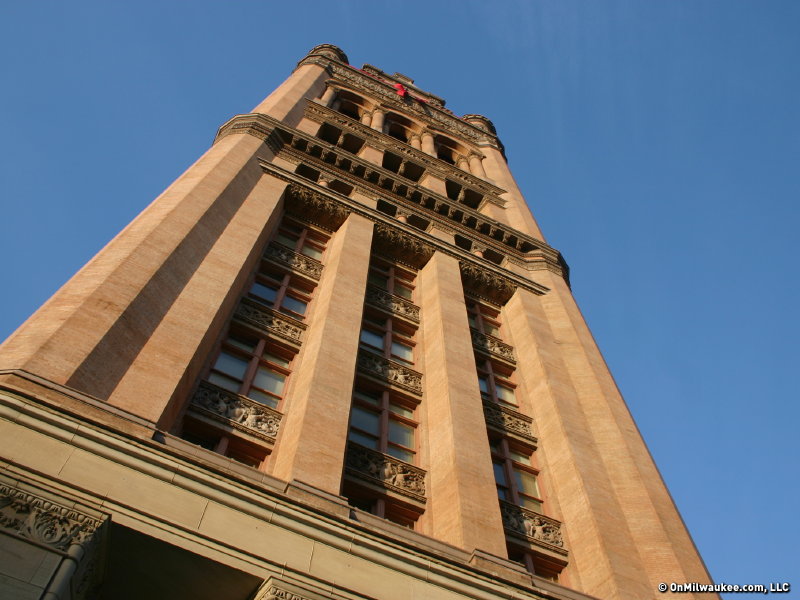When Milwaukee's City Hall was completed in 1893, it was a point of pride for Milwaukeeans; a symbol of the growing city's importance.
At the time, the nation's third-tallest structure -- and the world's largest inhabitable building, from top-to-bottom -- behind the U.S. Capitol and Philadelphia's then-unfinished City Hall, stood watch over the city, which was coming into its own as one of the nation's leading shipping centers.
As time passed, however, City Hall -- made famous by television's "Laverne & Shirley" and used as a symbol by a number of civic organizations -- had fallen into disrepair. Its powerful bell was silenced by fears vibrations would cause structural damage.
Thursday night, as a fierce winter storm approached the city, hundreds gathered at the corner of Water and Wells Streets to watch City Hall officially reopened in its original glory. The clock, painted over decades ago to cover up a soot buildup, was returned to its original translucent design and illuminated. And the bell, silent for three years and rung only on special occasions prior to that, rang out over the city once again.
"City government has never looked brighter," quipped Mayor Tom Barrett.
The festivities capped off a three-year renovation that cost $70 million. It was a unique project, performed by a trio of area firms. Engberg Anderson, based in the Third Ward, handled the architectural work, working of Henry Koch's original designs.
J.P. Cullen Construction led the rebuilding duties, painstakingly removing nearly every brick from the building's south tower and repairing years of neglect, wear and tear. Such a project wasn't new for the firm, which also did the $100 million facelift of the Capitol in Madison -- but nonetheless provided some on-the-fly adjustments.
"With historic renovations, you never really know what you're going to get into until you get in there," said J.P. Cullen's Craig Eide. "You have to take it apart to figure out how to fix it. We had drawings of what we thought it was, when you actually get out there, you have to take it completely apart to know what's really there.
"Even though there's repeating elements, each and every one was different. Everything is handmade and unique on the job."
Even with the complex nature of the project, Cullen was able to get the job done on time and, more importantly, on budget. The team was so efficient that it was able to complete a number of tasks originally intended to be done only if there was extra money available at the project's end.
Some of those jobs included the complete removal and replacement of the upper slate, installation of new copper on the north tower and rebuilding the dormers. The construction team also repaired some patches of old steel discovered during the project.
The original clock was uniquely designed. It was one of just two pneumatic clocks in the world. A clock on the ground level of the building sent compressed air blasts up the tower, moving the hands of the two clocks in unison.
The original clock was installed in 1886 by Johnson Service Corp., a forerunner to Johnson Controls. The original translucent face -- clouded with soot and coal dust -- was painted over in the 1920s, giving the clock a black face with white hands.
The new clock is based on the original design and will be illuminated from behind, as it was originally.
The 20,000-pound bell, nicknamed "Solomon Juneau" in honor of Milwaukee's first mayor and one of its three original founders, has also been restored.
When it rang for the first time on New Year's Eve, legend says it could be heard as far as Racine and Oconomowoc. The bell was silenced by Mayor Daniel Webster Hoan in 1925, who claimed to have suffered migraine headaches from the sound.
"Not many people realize that there was a family that lived in the tower and was responsible for ringing the bell," Barrett said. "Mayor Hoan said he silenced the bell because of structural concerns, but it was decades later that we learned about his migraine headaches."
After Hoan's decree, the bell fell silent for 15 years, and rang again on July 4, 1940 to mark Independence Day. It wouldn't toll again until New Year's Eve 1999.
When installed in 1895, it took four men nearly 16 hours to raise the bell to the tower, a fact not lost on the current mayor, who saluted the crews that rebuilt the city 's most-recognized building.
"Picture us standing here 100 years ago, after this building was built by people without the equipment or technology that we have today," Barrett said.
Hundreds of workers worked on the project, including a large percentage that completed their apprenticeships. During the dedication ceremony, Mayor Barrett applauded the contractors for exceeding city-established mandates for minority and emerging-business participation.
Barrett, who took office in 2004, was looking forward to walking around the building without dodging construction workers or equipment. A native Milwaukeean, he appreciates the significance and history of the building and is a fan of some of its sometimes-quirky trivia.
He's especially partial to a set of paintings in the common council chambers, which depict City Hall, the State Capitol and the U.S. Capitol in Washington.
"I worked in all three of those places," Barrett said. "That's my personal favorite part."
The renovation efforts came not long after City Hall was designated a National Historic Landmark, an honor bestowed in April 1995. City Hall workers endured three years of noise and temporarily-relocated offices and passers-by on Water Street became accustomed to scaffolding blocking the sidewalks.
Now, with just some minor cleanup and last-minute touch-up work remaining, the bricks are back, the scaffolding is gone and City Hall is again standing proud in the heart of Downtown.
"The braces are off and the teenager can smile again," Barrett said.







